How a cringey Costco surfboard sparked a ‘foamie’ revolution
Cabrillo Beach is not a great surf spot. And Allison Scinta is not a great surfer — yet.
Despite the San Pedro spot’s small waves that only last a few seconds, she’s able to get up and have fun, thanks to a well-used soft-top surfboard she bought on Craigslist for $40. Instead of being surrounded by other new riders on soft-tops, Scinta has been pleased to see more experienced surfers on similar boards.
“I think those people are giving the rest of us who ride soft-tops a good name and making it seem like we might actually be legit,” she said.
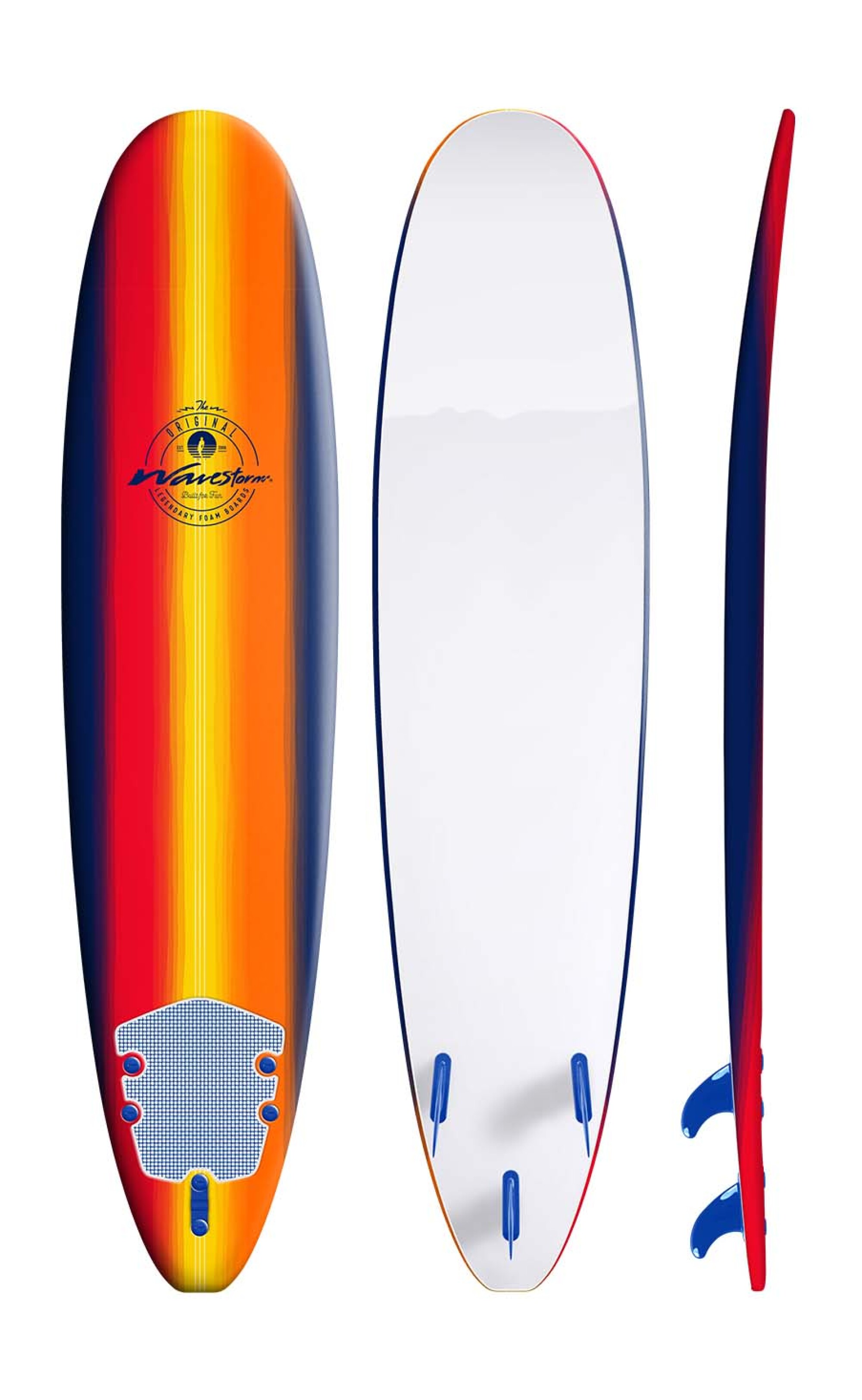
The Wavestorm 8-foot Classic Surfboard sold at Costco for $99, but after switching manufacturers, they now go for about $215 to $360, depending on the model and size. Costco no longer carries the foam boards.
(Stan Moniz)
Riding a soft-top board used to be like surfing under a giant neon sign declaring there was a beginner in the lineup. Now, a new crop of surfboard companies are selling higher-performance soft-top boards that everyone from weekend warriors to pro surfers is willing to be seen on.
As Scinta gets better at surfing, she is considering getting a new board. But it won’t be a traditional one made of fiberglass or epoxy, a typical next step for many surfers.
“I know a lot of people really are excited for their first epoxy board,” she said. “But I’ll probably just get another soft-top that’s not as beat-up as my current one.”
Foam-top boards — colloquially known as foamies — are lighter and safer for beginners, with softer material that is less likely to hurt a rider during a fall, and can be half the cost of their hard-top counterparts. They also used to get waterlogged easily and were tough to maneuver in the waves. Advancements in shape, fin design and foam type have improved their buoyancy and agility, making those soggy, slow boards a thing of the past.

May Gong, 10, of New York learns to surf in Santa Monica with Go Surf LA.
(Allen J. Schaben / Los Angeles Times)
The Wavestorm launched this new era of foamies in 2006 when AGIT Global, a Taiwanese sporting goods company specializing in foam, put about 400 blue 8-foot boards in 10 Costcos across California to test the market for their creation.
“After a couple of days, I got a call asking, ‘How quickly can you make more of these?’” said Matt Zilinskas, AGIT Global’s chief business development officer.
The boards took off. Costco sold the Wavestorms for $99 until 2020, when the retailer, which declined to comment for this story, switched to a new surfboard manufacturer. Wavestorms now go for about $215 to $360, depending on the model and size, on Amazon and in surf shops. Zilinskas said AGIT Global is closing in on selling more than 1 million Wavestorms across the globe.
With all those new boards come more people in the water. Some surfers grumble about the crowded lineup, blaming the explosion of soft-tops, a complaint that Zilinskas has heard a lot and dismisses.
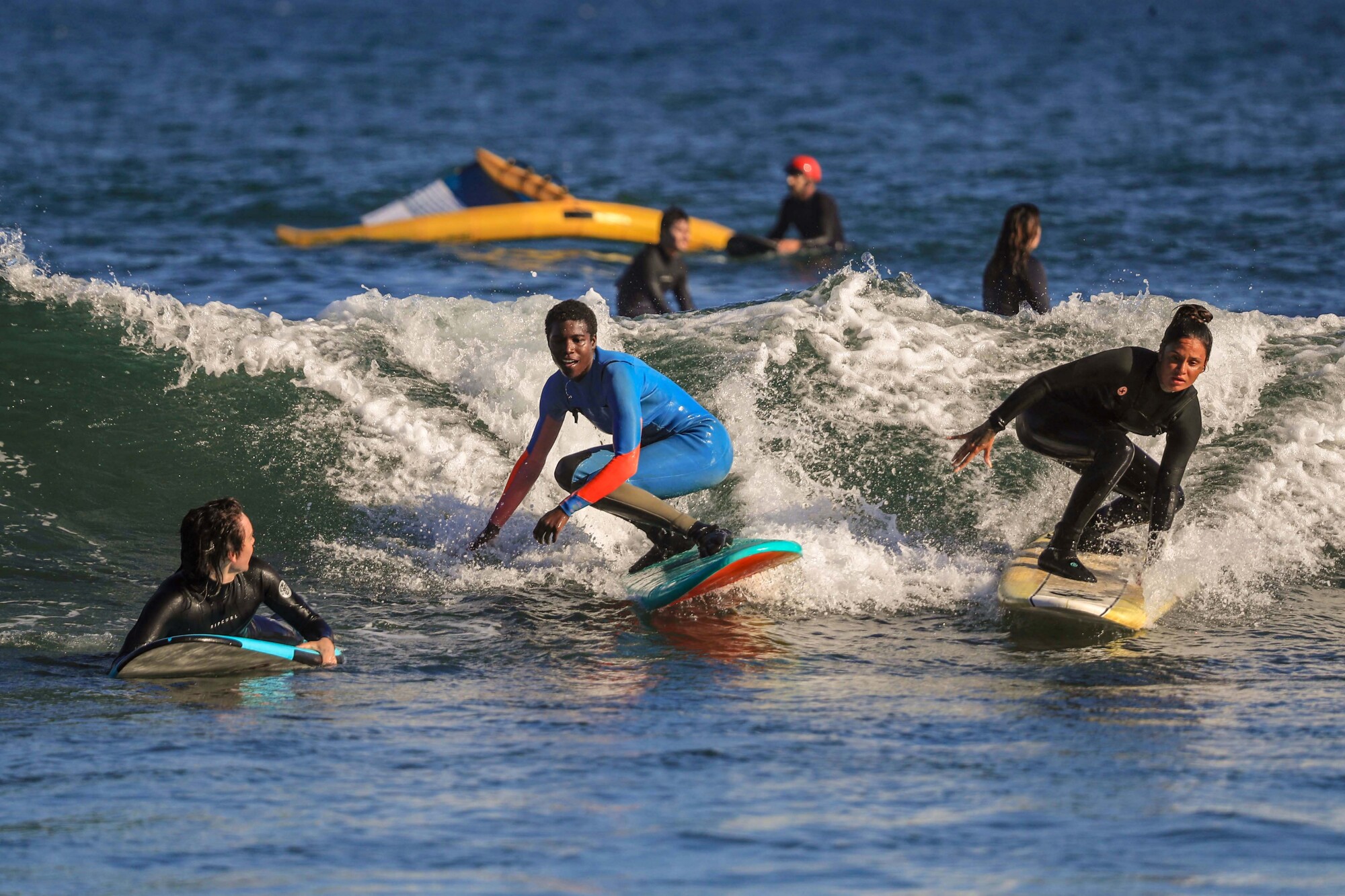
Natasha “Tashi” Smith, center, surfs on a foam surfboard at Topanga State Beach.
(Allen J. Schaben / Los Angeles Times)
“The ocean is for everyone,” he said.
Daniel Bennett, who grew up in L.A., doesn’t mind the crowds or the soft-tops. Bennett switches between going out on a Wavestorm or shorter hard-top depending on the conditions and says that the beach has always been a draw in Southern California.
“People move here and say they want to try surfing,” he said. “I think that is where Wavestorms come in handy. You can’t hate on someone for trying.”
Foamies catch a killer wave
Beyond getting more people in the water, Wavestorms helped create a market for soft-top board makers. Competitor Catch Surf, based in San Clemente, is known for its foamies’ various shapes and colorful designs. Its first board, the Beater, could ride like a surfboard or be used as a bodyboard or skimboard after taking off the fins. It was a hit in 2008 during its first summer, a time when people want to play at the beach no matter what the waves are like.

Catch Surf’s Odysea LOG surfboard.
(Catch Surf)
“We kept it fun and bright, but we want these things to perform the best they can,” said Chris Monroe, Catch Surf’s vice president of marketing.
Now Catch Surf has 50 different board shapes, including the well-known Odysea series; partners with Red Bull for soft-top surfing competitions; has one of its models as the first soft-top board in the Surfing Heritage and Culture Center in San Clemente; and worked with Lost Surfboards, a premier hard-top surfboard company, to create a foamie version of one of its popular shapes.
The first soft-top came out in the 1970s when Tom Morey, who had a bodyboard factory, and Mike Doyle, a surfer, collaborated on creating a surfboard, said Matt Warshaw, a surf historian and author of “The Encyclopedia of Surfing.” It wasn’t until the last 15 years that the industry started developing boards that could do more than these first models.
“Without undercutting any of the safety or softness, these new manufacturers made the boards less sluggish,” he said. “They pushed them closer to being regular surfboards.”
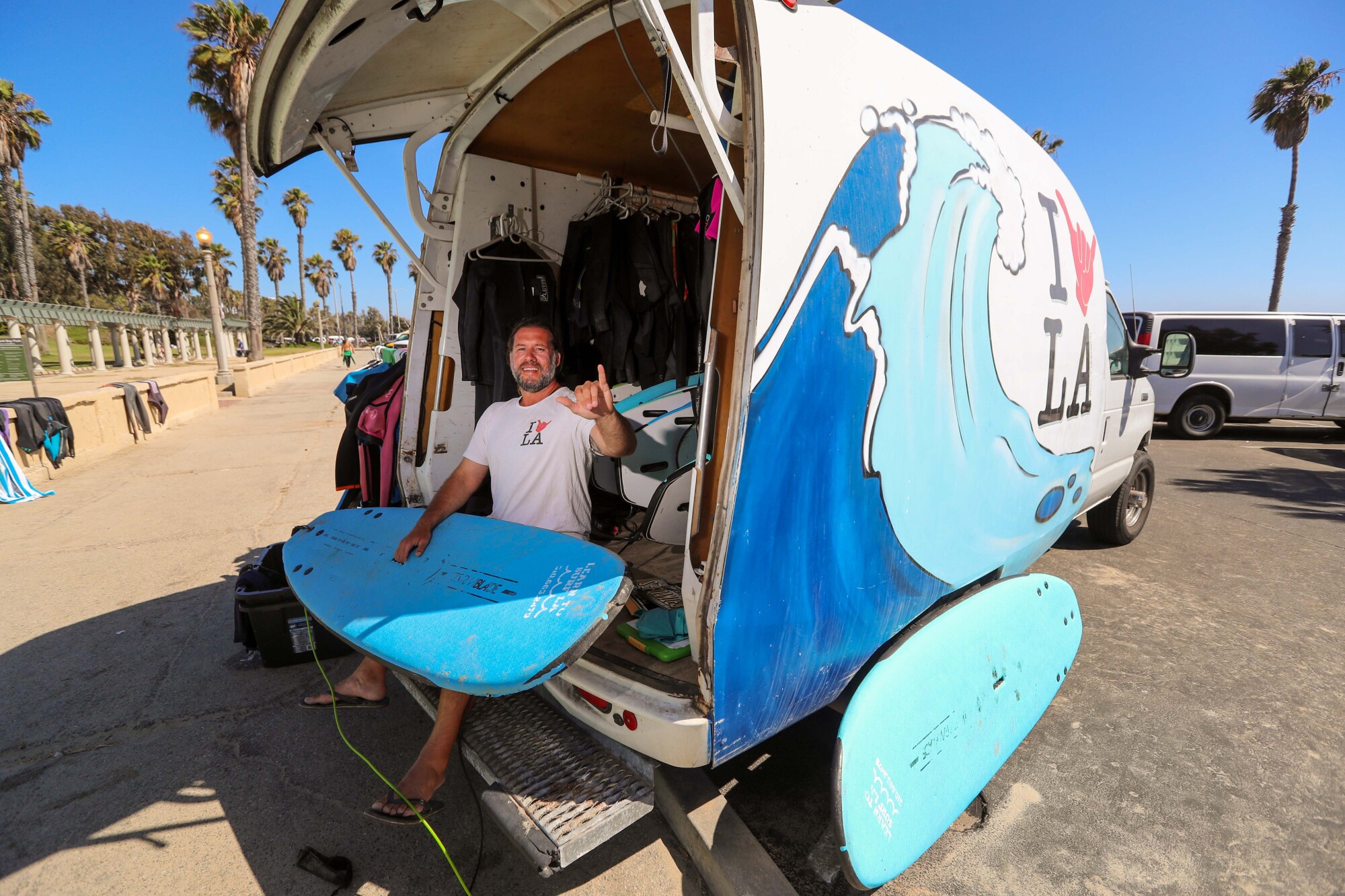
Peter Paris, owner of Go Surf LA surf school, poses with his soft-top surfboards in between teaching classes on the weekend in Santa Monica.
(Allen J. Schaben / Los Angeles Times)
The difference is clear to Peter Paris, who owns Go Surf LA, a surf school located in Santa Monica. Once the school switched to Wavestorms more than a decade ago, classes got easier.
“People are getting it faster,” he said. “People are getting more out of their first hour.”
It’s not just beginners. Paris, a lifelong surfer, said the first time he went out on a Wavestorm was a revelation.
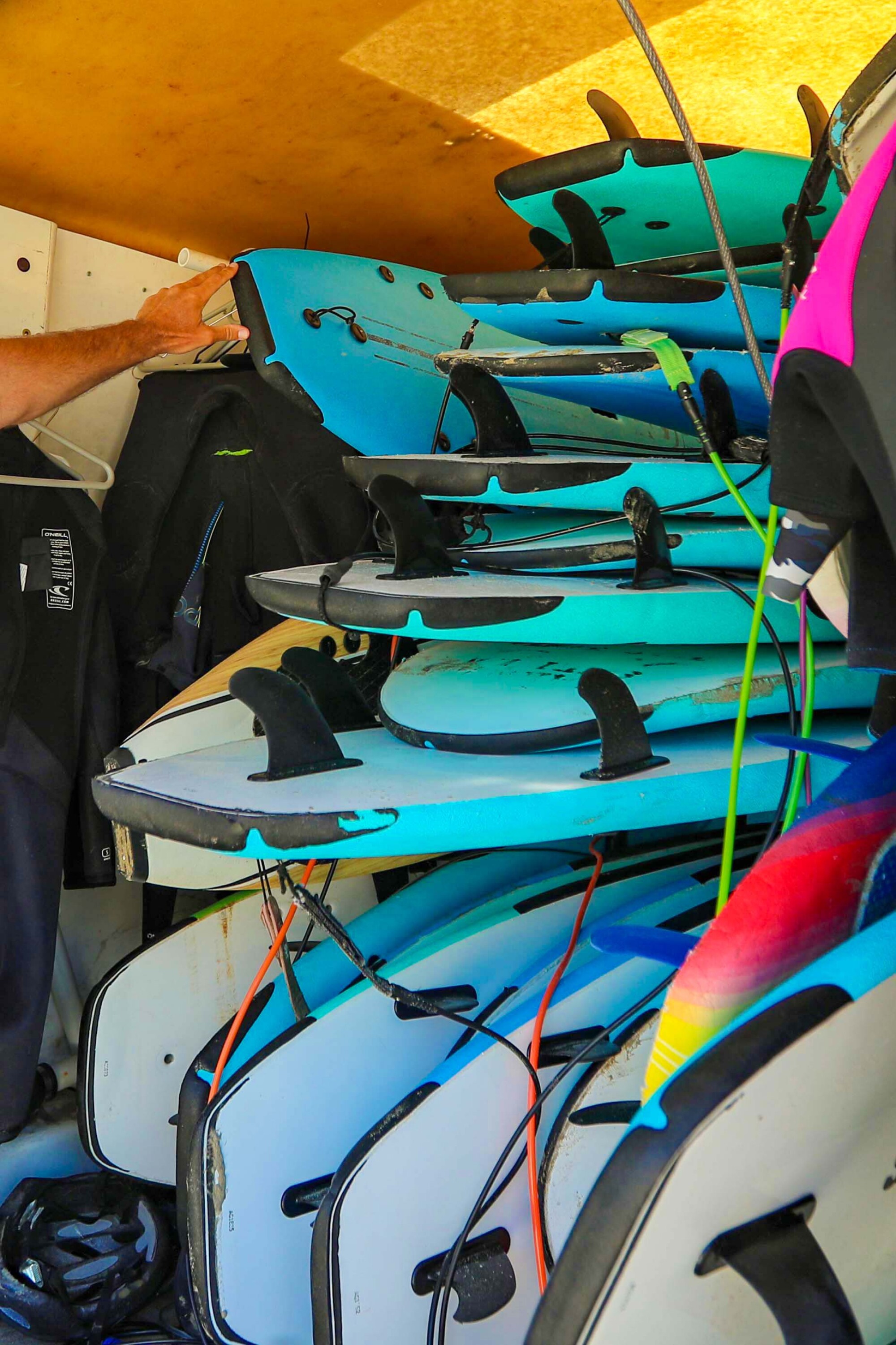
Peter Paris, owner of Go Surf LA surf school, teaches with soft-top surfboards.
(Allen J. Schaben / Los Angeles Times)
“I was really pumped at getting a good turn in on a soft-top,” he said. “I thought, ‘Whoa, this might be better than a hard-top.’”
Paris rarely goes out on hard-tops anymore and even has a vanity license plate that says “Foamies.” He said he’s noticed a change in other people surfing too. He credits the rise of soft-tops and COVID-19 for prompting a vibe shift in surfing.
“Everyone used to want to be Kelly Slater,” he said, speaking about the pro surfer with a record 11 wins from the World Surf League. “Now they want to float in the ocean and get a couple of waves and not be stressed.”
Even surf pros have fun on soft-tops
But no one has done more to legitimize surfing soft-tops than Jamie O’Brien, a pro surfer from Hawaii who grew up near Pipeline, a famous surf spot that hosts pro competitions. In 2011, he surfed Pipeline on a Wavestorm; the video of that session shows a mix of him goofing around and getting barreled.
“My whole goal with surfing has always been to have the most fun,” he said. “I don’t know why, but I have the most fun in my life on these boards.”
Now, he’s sponsored by Catch Surf and has a line of his own boards with the O.C. brand. He also teaches on one of his Catch Surf boards at his Oahu surf school, which he thinks is part of the draw for new surfers.
“It’s sick that I could ride the same board at Pipeline that I’m teaching someone how to surf [on] for their first time,” he said.

Natasha “Tashi” Smith with a foam surfboard at Topanga State Beach.
(Allen J. Schaben / Los Angeles Times)
One of the people inspired by O’Brien’s embrace of soft-tops was Natasha Smith, who said she saw his video on YouTube of his Wavestorm antics not long after she tried surfing for the first time on a work trip to California in 2017. She took a surf lesson and was hooked. Smith moved to Los Angeles six months later and has been surfing most days on one of her five soft-tops since then.
“If I was on a regular surfboard, I’d probably rip so hard,” she said. But “soft-tops are a passion point of mine.”
She likes how cheap they are and how she can catch waves no matter how small. She’s also out in the waves with others on similar boards.
“Now everyone has a Wavestorm in their quiver,” Smith said. “It’s not as much of a stigma.”
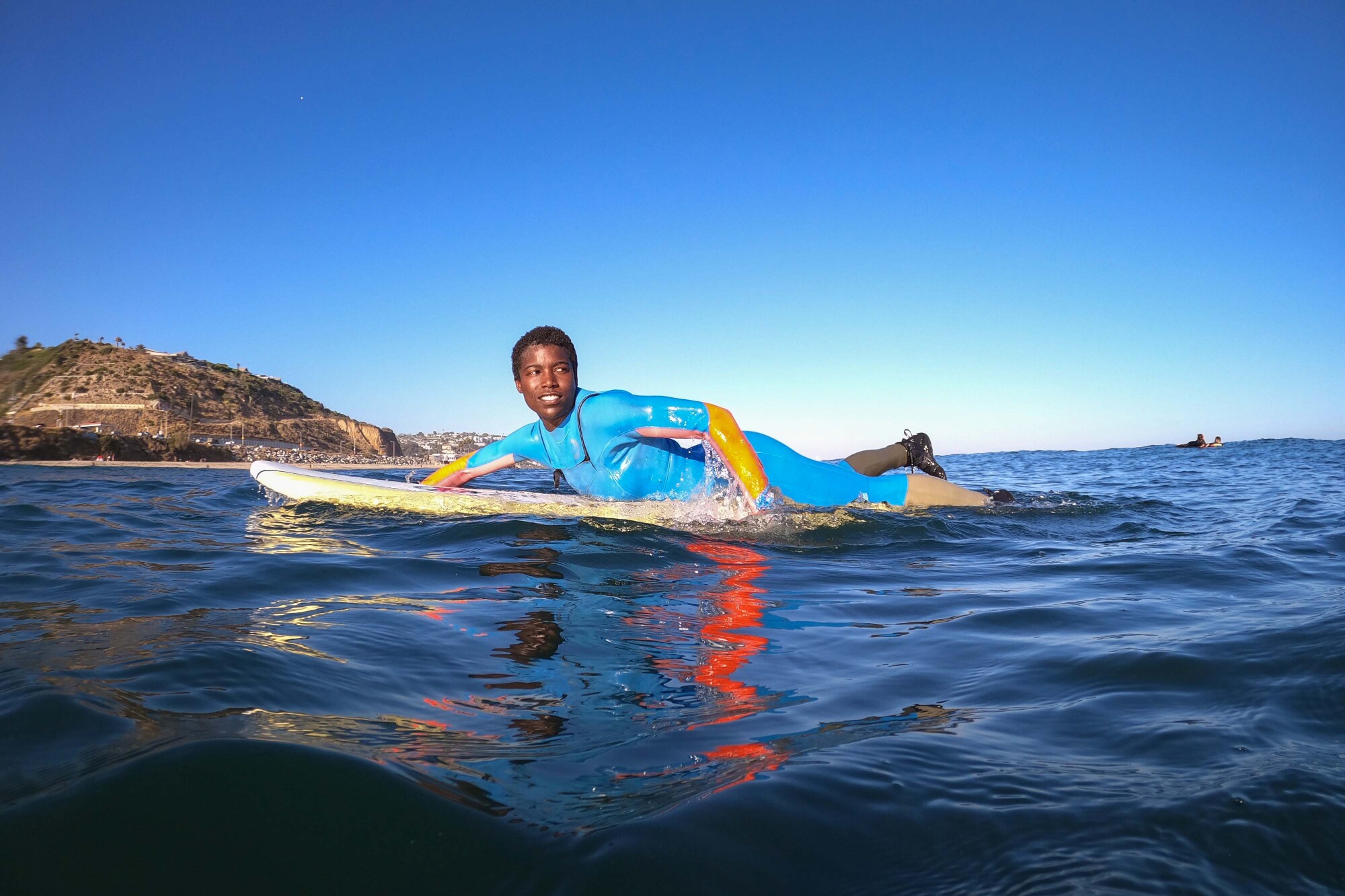
Natasha “Tashi” Smith surfs on a foam surfboard at Topanga State Beach.
(Allen J. Schaben / Los Angeles Times)
For all the latest Life Style News Click Here
For the latest news and updates, follow us on Google News.
